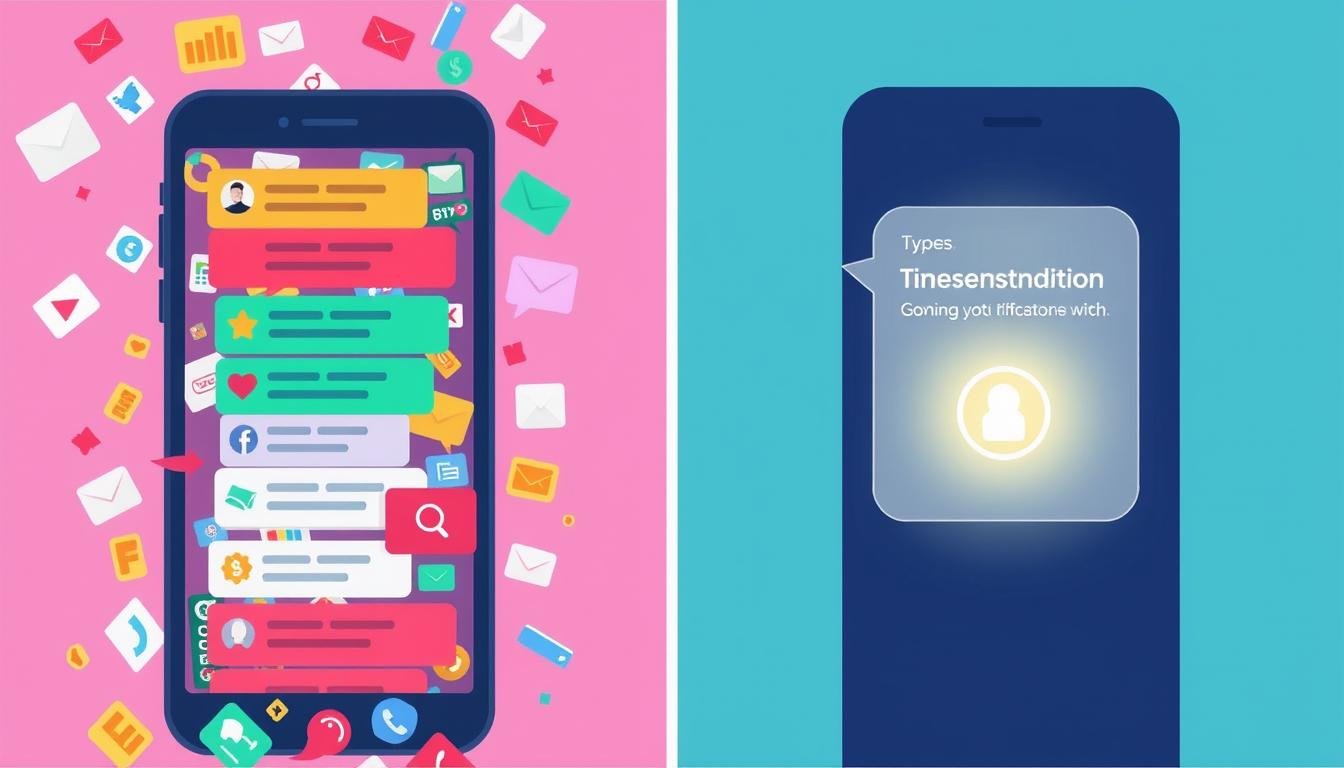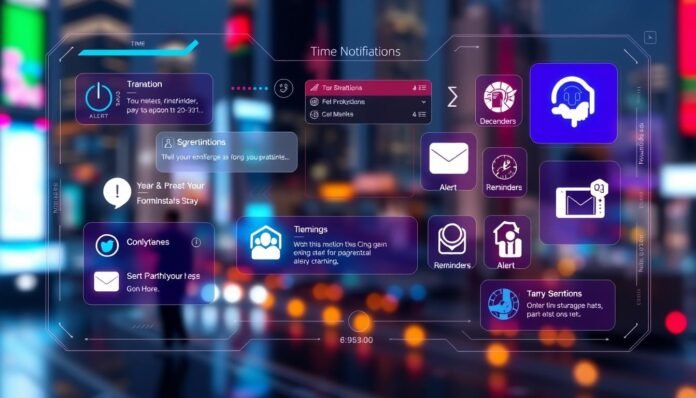A futuristic digital interface displays a variety of time-sensitive notifications, featuring vibrant colors and sleek technology elements. Icons representing alerts, reminders, and messages are overlaid on a blurred cityscape background, conveying urgency and connectivity.
Digital communication has changed how we get important information. Time-sensitive notifications are a new way to send urgent alerts.
These tools help users stay informed about key updates. They work across many platforms.
Time-sensitive notifications connect people with real-time info. They highlight critical messages that need quick action.
Modern tech sends these alerts instantly. Users never miss crucial updates.
These notices are vital for everything from emergencies to money matters. They can make big differences in personal and professional life.
Businesses and people rely on these urgent alerts. Quick updates are key in our fast-paced world.
Understanding these notifications is essential for good information management. This guide will explore how they work and help us.
Understanding Time-Sensitive Notifications
Time-sensitive notifications are key in our fast-paced digital world. They deliver urgent information quickly to users across various platforms.
These alerts exist in many modern communication systems. Mobile apps and emergency networks use them for urgent messages.
Financial firms use them for transaction warnings. Healthcare providers use them for patient care updates.
Time-sensitive notifications cut through the digital noise. They highlight info that needs instant recognition.
These alerts have unique visual or audio cues. Colour-coded alerts and distinct sounds help grab user attention fast.
Tech advances have changed how we receive these alerts. Smart devices and cloud computing enable the quick delivery of urgent information.
Users can now customize their notification settings. This ensures they get the most relevant alerts.
Time-critical alerts are vital in our digital world. They help manage complex info by delivering urgent messages quickly.
How Do Time-Sensitive Notifications Work?
Time-sensitive notifications use a complex alert system. They send instant messages across digital platforms.
Apps trigger notifications that need quick user attention. Push notifications cut through digital noise to deliver key info.
Notification delivery uses advanced backend tech. iOS and Android have systems that prioritize urgent messages.
Intelligent algorithms decide which alerts to show right away. Devices use fast routing to send push notifications quickly.
Time-sensitive alerts go through many checks. The system looks at user choices and device settings.
Users can pick how they get urgent notifications. This lets people manage alerts and control their digital experience.
Good notification delivery depends on context. Innovative systems look at user habits to send important messages.
Benefits of Time-Sensitive Notifications
Time-sensitive notifications deliver real-time info straight to users. They change how we share essential data across platforms.
These tools boost communication by reaching users at crucial moments. Emergency alerts and urgent messages can now be sent instantly.
Users get quick updates about time-critical events. This allows for faster decision-making in various situations.
Businesses can improve customer engagement with these notifications. They can also create more personalized communication strategies.
These tools have improved customer satisfaction in many sectors, including retail, healthcare, and finance.
The tech behind these notifications keeps improving. It offers more innovative ways to deliver key information.
As digital systems connect more, these alerts will be vital. They’ll keep users informed and connected in new ways.
Differences Between Regular and Time-Sensitive Notifications
This is a split-screen illustration depicting two contrasting notification types: on one side, a cluttered smartphone screen filled with colourful, general notifications like social media alerts and reminders; on the other side, a streamlined screen showcasing a single, glowing time-sensitive notification with an urgent visual cue. Use vibrant colours for the regular notifications and a more intense, focused light for the time-sensitive alerts. Include visual elements like clocks or urgency symbols to emphasize the difference in importance and immediacy.
Regular notifications blend into the background. Time-sensitive notifications demand immediate interaction.
Time-sensitive alerts use bright colors and urgent sounds. These elements ensure that users notice critical information right away.
Regular notifications include social media updates. Time-sensitive alerts cover emergencies and critical system updates.
Users can customize how different notification types appear. Smart devices can sort alerts based on urgency.
Knowing these differences helps users control their digital experiences. They can ensure they never miss important information.
Best Practices for Implementing Time-Sensitive Notifications
A sound notification strategy needs careful planning. It’s about sending helpful info at the right time.
Clear messages are key for notifications. They should be short and easy to understand.
Users should be able to choose their notification settings. This helps keep alerts relevant and welcome.
Use smart filters to send only the most critical alerts. Not all updates need to be sent right away.
To ensure that notifications reach users quickly on all devices, you can use push notifications, SMS, or email.
Check how well your notifications work often. This data helps improve user experience over time.
Challenges in Using Time-Sensitive Notifications
Time-sensitive notifications present complex challenges for developers and users. Notification fatigue is a critical issue in digital communication.
Users feel overwhelmed by constant alerts. This leads to decreased engagement and potential information burnout.
Privacy concerns are another significant obstacle. Consumers want control over their digital notifications.
Intrusive alerts can create negative experiences. This may cause users to turn off notifications or uninstall apps.
Technical limitations add to these challenges. Different devices need unique notification strategies.
Developers must navigate complex ecosystem requirements. They ensure seamless delivery across various devices.
Successful implementation needs innovative approaches. Systems must balance urgency with user preferences.
Adaptive algorithms can help reduce notification fatigue. They learn individual communication patterns to maintain critical information delivery.
Strategic approaches include customized notification settings, intelligent prioritization of alerts, user-controlled frequency thresholds, and context-aware delivery mechanisms.
Organizations must focus on user experience. Understanding user psychology and tech limits is key.
Future Trends in Time-Sensitive Notifications
AI is changing how we get digital alerts. Smart tech will soon understand what each person likes and needs.
Clever systems will guess what you want before you ask. They’ll use your habits to send just the correct info.
New tech like AR will make alerts more fun. You’ll get important news right when you need it.
AI will make alerts more innovative and more functional. It will look at where you are and what you’re doing.
Future alerts will know just what you need. They’ll send the right message at the perfect time.
Conclusion: Maximizing the Effectiveness of Time-Sensitive Notifications
Time-sensitive notifications are key to modern digital communication. They deliver critical info when users need it most.
Smart notifications boost user engagement. They must be carefully crafted and timed.
Organizations need top-notch systems that respect user experience. These systems should provide timely, relevant information.
Good notification frameworks need ongoing learning and tweaking. Apple and Google have shown how intelligent systems can change user interaction.
Using machine learning can make notifications feel helpful, not pushy. This approach helps build stronger ties with audiences.
As digital worlds change, mastering timely alerts grows more vital. User-focused design and clear communication are key.
The future lies in competent, responsive notification tech. This tech will help create better connections with users.
FAQ
What exactly is a time-sensitive notification?
A time-sensitive notification is an urgent alert for critical information that requires immediate attention and action from users.
These alerts are prioritized to ensure quick updates on emergencies or limited-time offers.
How do time-sensitive notifications differ from regular notifications?
Time-sensitive notifications have higher priority and use distinct visual cues. They often bypass standard settings to ensure immediate user awareness.
Which devices support time-sensitive notifications?
Most modern smartphones, tablets, smartwatches, and computers support time-sensitive notifications. Users can customize urgent alerts across various applications on these devices.
Are time-sensitive notifications always intrusive?
Not always. Many platforms offer control over how these notifications are displayed. Users can set preferences for interruption levels and custom alert settings.
What are some common examples of time-sensitive notifications?
Weather warnings, emergency alerts, and flight delay notifications are common examples. Banking fraud alerts, stock updates, and promotional offers are also time-sensitive.
How can businesses effectively use time-sensitive notifications?
Businesses should ensure messages are concise, relevant, and genuinely urgent. They should respect user preferences and provide immediate value.
Advanced targeting helps deliver notifications that genuinely require immediate action.
What privacy concerns exist with time-sensitive notifications?
Privacy concerns include data tracking and unauthorized access to personal information. Users should review app permissions and use privacy settings carefully.
Can users customize time-sensitive notification settings?
Yes, most devices and apps offer extensive customization options. Users can adjust priorities, set quiet hours, and choose specific urgent alerts.
you may also read : Johnny Dang Net Worth – Celebrity Jeweler’s Wealth Revealed
